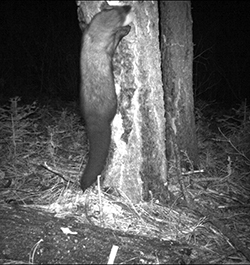
Scientists with the California Department of Fish and Wildlife (CDFW) and Oregon State University recently published the results of a population study on fishers (Pekania pennanti) in northern California and southern Oregon. Led by CDFW Wildlife Statistician Dr. Brett Furnas and three coauthors, CDFW Senior Environmental Scientist Richard Callas, CDFW Research Analyst Russ Landers and Dr. Sean Matthews of Oregon State University, the study produced the first-ever robust estimates of density and size of the fisher population in northern California.
“This is the first time we’ve come up with a solid number of fishers, which is a starting point for tracking and monitoring populations,” Furnas said. “One of the most important tools we have used so far to help this species is reintroductions, so now -- with a baseline established and ongoing surveys planned -- we’ll be able to see if the population is really rebounding over time.”
Fishers in northern California and southern Oregon represent the largest remaining population in the Pacific states. The species once ranged from the state of Washington southward through Oregon and California. Currently, fishers occupy only a small portion of their historical range in that region. In California, fishers are found in the northern areas of the state and a small, isolated population occurs in the southern Sierra Nevada Mountains.
CDFW and the U.S. Fish and Wildlife Service have been petitioned on several occasions to list fishers as threatened or endangered under their respective Endangered Species Acts.
In 2016, while considering fishers in the southern Sierra Nevada Mountains of California, the California Fish and Game Commission voted that the petitioned action was warranted in part, choosing to accept the petition in the context of the Southern Sierra Nevada Evolutionarily Significant Unit, and adopted findings to that effect, which were published on May 6, 2016. Although fishers are relatively well-distributed in northern California and in portions of southern Oregon, data from existing surveys and prior studies was used to estimate abundance. This information is critically important to assess the status of fishers and serve as a baseline for conservation efforts.
Furnas and his coauthors used data from camera traps, hierarchical modeling of detections and non-detections of fishers from the cameras, and information about fisher home range size to develop their estimate of population size. They estimated that approximately 3,200 fishers occur within the northern California and southern Oregon study area, with an average density of 5.1 to 8.6 fishers per 100 square kilometers.
Estimating the sizes of wildlife populations is challenging, particularly for species such as the fisher that are difficult to observe and occur over large areas. A final population estimate for the fisher would not have been possible without the cooperation of a variety of federal and tribal agencies, universities and private landowners who shared datasets that were combined to complete the modeling. With these data, Furnas and his coauthors demonstrated that estimating the population size of the fisher at large geographic scales is feasible. They also suggested that the methods used in their research could be used to estimate the abundance of other carnivores, including black bear, gray fox and coyote.
The study was published in the journal Ecosphere.  More information / view publication
More information / view publication